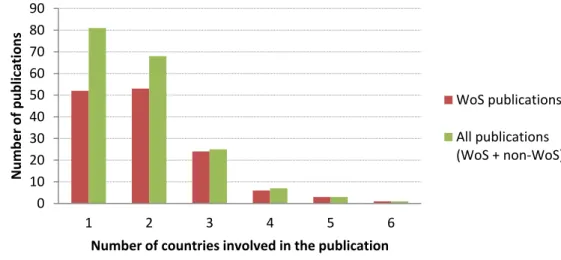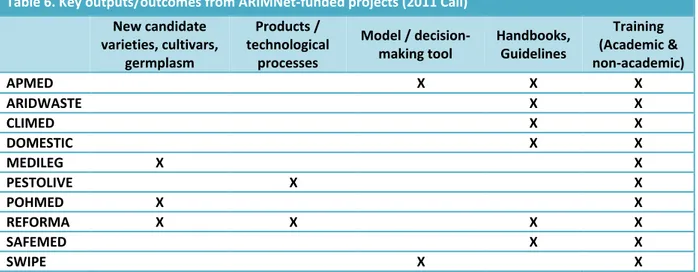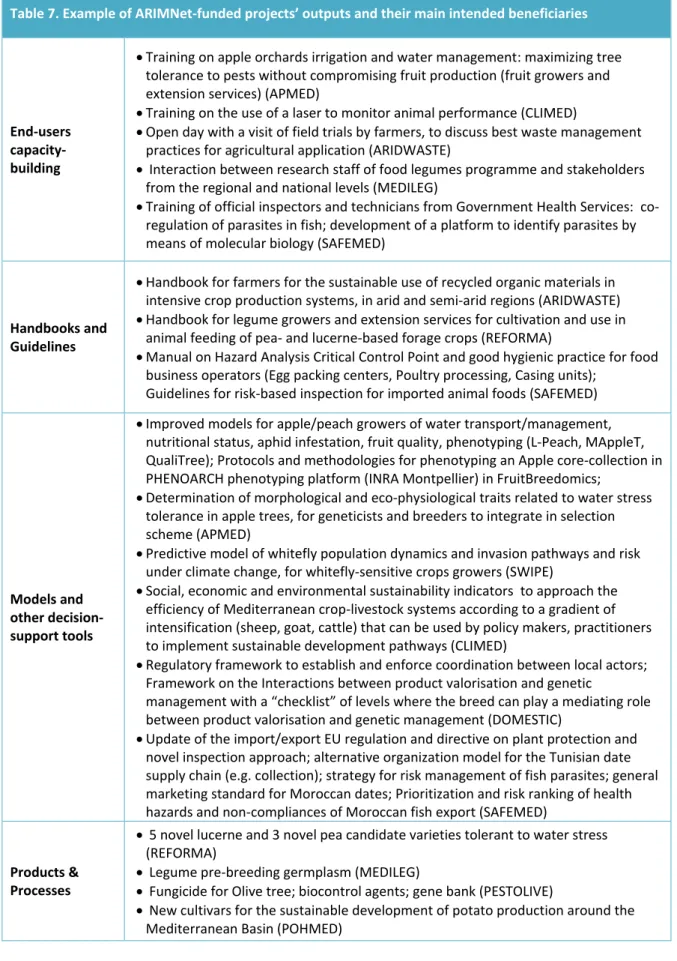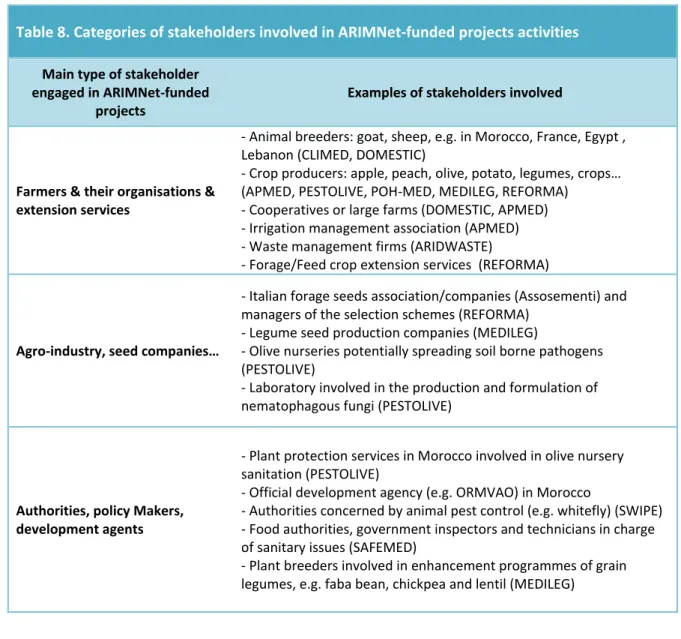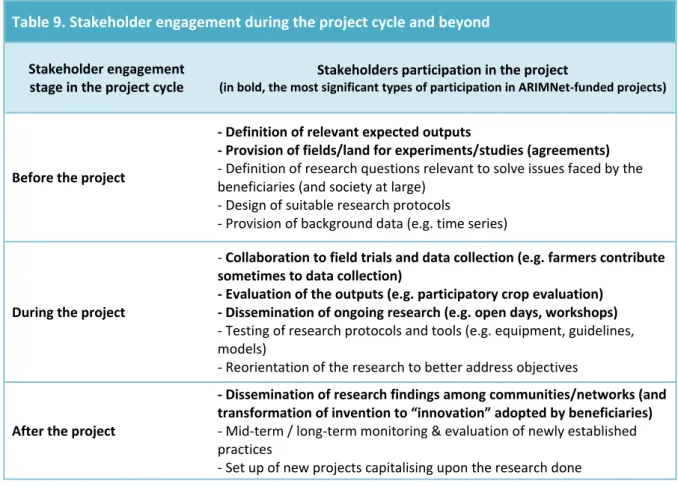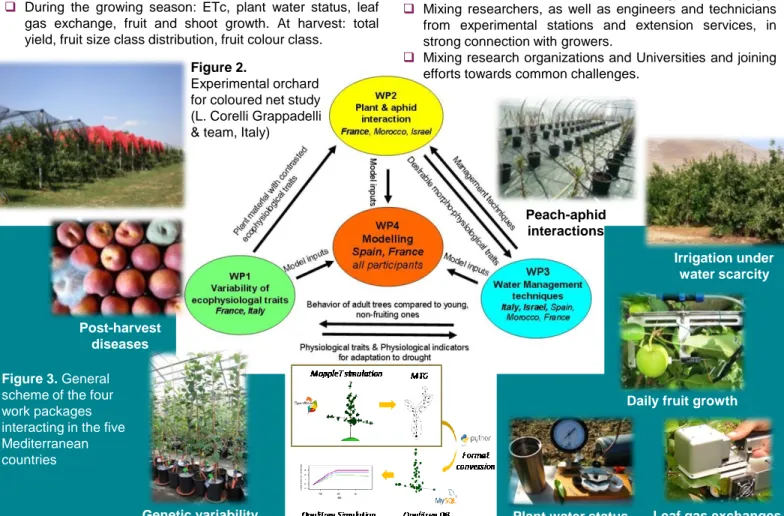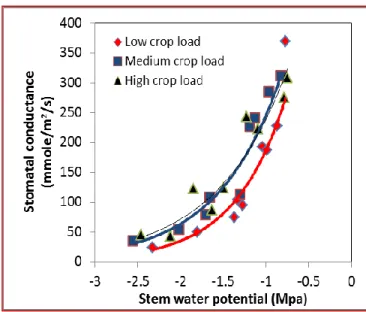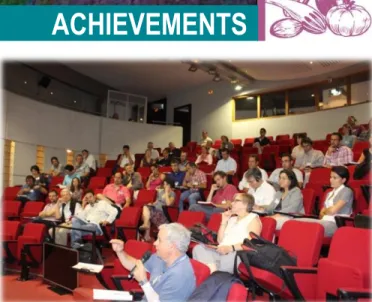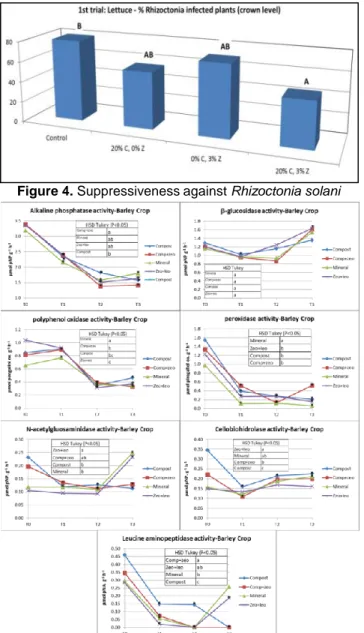HAL Id: hal-02789508
https://hal.inrae.fr/hal-02789508
Preprint submitted on 5 Jun 2020
HAL is a multi-disciplinary open access
archive for the deposit and dissemination of
sci-entific research documents, whether they are
pub-lished or not. The documents may come from
teaching and research institutions in France or
abroad, or from public or private research centers.
L’archive ouverte pluridisciplinaire HAL, est
destinée au dépôt et à la diffusion de documents
scientifiques de niveau recherche, publiés ou non,
émanant des établissements d’enseignement et de
recherche français ou étrangers, des laboratoires
publics ou privés.
Results of the research projects funded by the
ARIMNet 2011 joint call
Dominique Fournier, Fabrice Gouriveau, Ali Rhouma, Sanaa Zebakh, Florence
Jacquet
To cite this version:
Dominique Fournier, Fabrice Gouriveau, Ali Rhouma, Sanaa Zebakh, Florence Jacquet. Results of
the research projects funded by the ARIMNet 2011 joint call. 2018. �hal-02789508�
Results of the Research Projects funded
by the ARIMNet 2011 Joint Call
Dominique Fournier (INRA-UMARI), Fabrice Gouriveau (INRA-Moisa), Ali Rhouma (IRESA),
Sanaa Zebakh (IAV Hassan II), Florence Jacquet (INRA-Moisa)
Working
Paper - November 2018
ARIMNet2 has received funding from the EU 7
thFramework
Programme for research, technological development and
demonstration under grant agreement no. 618127
2
TABLE OF CONTENTS
TABLE OF CONTENTS ... 2
1
Introduction ... 3
Analysis of academic outputs ... 5
1.1
1.1.1
Methodology to assess academic outputs ... 5
1.1.2
Overall scientific & technical production ... 6
1.1.3
Yearly scientific production ... 6
1.1.4
Journals and Research Areas ... 7
1.1.5
Geographical distribution of the publications ... 8
1.1.6
Co-publications ... 9
1.1.7
High impact publications – distribution by top WoS citations ... 9
Analysis of non-academic outputs ... 10
1.2
1.2.1
Methodology to assess non-academic outputs ...10
1.2.2
Non-academic outputs and potential outcomes ...11
1.2.3
Stakeholders involvement ...13
Conclusion ... 15
1.3
ANNEX 1. Research Projects funded by the ARIMNet 2011 Joint Call ... 16
ANNEX 2. Assessment of the innovation potential of ARIMNet/ARIMNet2-funded projects ... 17
3
1 Introduction
The ARIMNet Project (Coordination of Agricultural Research in the Mediterranean Area) funded by
the European Union Seventh Framework for technological development and demonstration (FP7),
ran between 2008 to 2013, involving 13 partners and 5 associated partners/institutions from 12
Mediterranean countries (Algeria, Cyprus, Egypt, France, Greece, Portugal, Israel, Italy, Morocco,
Spain, Tunisia, and Turkey). It aimed at joining agricultural research forces to address in a
coordinated way the challenges that the Mediterranean agriculture is facing.
In 2011, ARIMNet Partners launched a Joint Transnational Call for research proposals (hereafter
referred to as “2011 Call”), and together, they committed around 7 million euros in the form of a
common pot. Only Portugal was unable to commit funds at that time, but it then participated to all
three calls launched in 2015, 2016 and 2017 under ARIMNet2, another ERA-Net (FP7; 2014-2017)
coordinated by INRA building upon ARIMNet, and involving 24 partners from 15 Mediterranean
countries. The 2011 Call was the first of this kind, considering that it engaged funding agencies from
the north, east and south of the Mediterranean Sea, around shared topics and objectives. For many
of the South Mediterranean partners (ministries and research funding agencies), this was their first
Joint Call, an experience that they would further strengthen through ARIMNet2 Calls and other
initiatives.
The 2011 Call was prepared over several months by ARIMNet Partners, who jointly agreed upon
common eligibility criteria related to the call mechanism/procedure and the composition of the
research consortia (e.g. a minimum of three countries, including at least one from the north and one
from the south or east of the Mediterranean Sea). The call followed a single-step procedure: the
pre-announcement was made in May 2011, the full text published in June 2011, and the deadline for
project submission set to September 2011.
The Call strived to mobilise the Euro-Mediterranean R&I community around shared agriculture
challenges, highlighting the research stakes and advances needed on the topics identified. Beyond
that, it encouraged the development of multi/transdisciplinary and applied projects as a way to
enhance research impacts in the medium to long term. It proposed to fund research on three key
topics addressing the agriculture-food-environment-society nexus: 1. Production systems and their
components: developing sustainable agricultural production in a context of increasing ecological and
climatic stresses; 2. Food chain from production to distribution: enhancing the advantages of
Mediterranean agriculture in developing products with high added value; and 3. Landscape and
resources uses for agricultural and environmental purposes: sustainable management of land and
natural resources.
As a result, 86 research proposals were submitted and 79 were deemed eligible and were evaluated
by renowned researchers. The evaluation and ranking took place between December 2011 and
March 2012. Ten projects were finally selected for funding, which started in 2012 and lasted for
three to four years (they ended between May 2015 and December 2016) (Annex 1).
The projects funded through this call were monitored by ARIMNet partners to assess their progress
and outputs, through a commonly established monitoring framework including specific reporting
tools/indicators and regular meetings. A standard report was to be filled by project coordinators at
mid-term (covering the period Month 1 - Month 18) and at the end of their projects (covering the
period Month 1 – Month 36), which contains productivity/impact indicators including among others
scientific publications and/or patents, capacity-building activities, mobility (staff exchange),
dissemination actions, etc. Mid-term reports covering technical and financial aspects were assessed
both by Funding Agencies and by external scientific evaluators to assess project progress compared
to initial plans, and to propose corrective measures to address possible deviations.
4
Final reports were assessed by funding agencies to control the fulfilment of the project objectives
and their correct implementation from a scientific and financial point of view. Project coordinators
met with the Funding Agencies at mid-term (around Month 18) and at the end of their projects (after
Month 36) to expose their results/progress, and discuss issues affecting project implementation.
The ten projects funded produced a range of academic (e.g. scientific publications) and
non-academic (handbooks, new plant varieties, trainings, education, etc.) results, during their
implementation and after, which are described in the projects’ final reports and dissemination
materials.
This document provides an overview of the diversity of these results and relevance for the
Mediterranean agriculture and societies. It is based on an analysis carried out during the first
semester of 2018, i.e. about two years after the end of the projects. Using the usual terminology in
Research Impact Analysis (see box below), as part of the results, we consider in this analysis both
projects’ outputs (short term) and possible outcomes (medium-term), but could not realistically look
at the project’s impacts (long-term).
BOX 1. Impact terminology
Adapted from:
P-B. Joly, A. Gaunand, L. Colinet, P. Larédo, S. Lemarié, M. Matt (July 2015). ASIRPA: A comprehensive
theory-based approach to assessing the societal impacts of a research organization. Research
Evaluation, 24(4), 440-453. doi: 10.1093/reseval/rvv015
Blundo Canto G., Barret D., Faure G., Hainzelin E., Monier C., Triomphe B., Vall E. (illus.), 2018. ImpresS ex
ante. An approach for building ex ante impact pathways. Montpellier, France, CIRAD, 64 p. ISBN:
978-2-87614-738-6 . https://doi.org/10.19182/agritrop/00013
Outputs: Products generated by the research project, during or immediately after it (short-term),
for example scientific or non-scientific knowledge (publication, report, database, method, etc.),
professional or academic training, expertise, technology, network, etc.
Outcomes: It is the appropriation, after some time (medium-term), of the research/intervention
outputs by the actors interacting directly or indirectly with the research community, and leading
to new practices (agricultural or managerial), new organizations, or new rules, etc.
Impacts: Long-term effects, positive or negative, intended or unintended, direct or indirect,
induced by the project. They cannot be looked at during the life cycle of the projects. Several
years are needed to observe actual impacts.
Impact pathway: Description of a innovation process/path which highlights the causal
relationships between the inputs mobilized by a project, its outputs, and its outcomes, and the
1st and 2nd level impacts
Stakeholder: Person or group (excluding other scientists) (e.g. farmers, agro-industry, extension
services, policymakers...) who influences/is influenced by the research.
5
Analysis of academic outputs
1.1
1.1.1 Methodology to assess academic outputs
The academic outputs of the projects funded through the ARIMNet 2011 Call were analysed in
March/April 2018, approximatively two years after the end of the projects, using several sources of
information, mainly the Web of Science database and the projects’ final reports.
The corpus was built as follows:
1) Search in the Web of Science
TM(WoS): publications available at the date of analysis (March 2018)
acknowledging ARIMNet and/or one of the 10 funded projects (APMED, ARIDWASTE, CLIMED,
DOMESTIC, MEDILEG, PESTOLIVE, POH-MED, REFORMA, SAFEMED, SWIPE)
The following equations were used:
Equation 1: FT=((ARIMNET NOT (ARIMNET 2 or ARIMNET2)) OR (ARIMNET2 same 2011) OR
"Agricultural Research in the Mediterranean Area" OR (grant agreement Near/5 618127))
This search returned 109 publications.
Equation 2: FT=(((APMed near/2 (project or arimnet*)) OR “Apple and Peach in Mediterranean
orchards” OR “ANR-12-AGRI-0001“) OR (project NEAR/2 ARIDWASTE) OR (project NEAR/2 CLIMED)
OR (arim NEAR/2 DOMESTIC) OR (project NEAR/2 MEDILEG) OR ( (project NEAR/2 PESTOLIVE) OR
”Contribution of olive history for the management of soil-borne parasites in the Mediterranean
Basin”) OR ( (project NEAR/2 (“POH MED” or Pohmed) ) OR “Potato Health - Managed for Efficacy
and Durability”) OR (((arimnet or arimnet2) NEAR/5 REFORMA) OR (“Resilient, water- and
energy-efficient forage and feed crops for Mediterranean agricultural systems”)) OR ( (project NEAR/2
SAFEMED) OR "Food Safety regulations, market access and international competition") OR ((arimnet*
OR 219262) NEAR/2 SWIPE))
This search allowed to identify 7 additional publications (i.e. 116 publications in total)
2) Search in the projects’ Final reports (which compile all results, at the consortium level): these
reports were delivered by projects’ consortia in 2016 (3 reports: APMED, DOMESTIC and SWIPE) or
2017 (7 reports: ARIDWASTE, CLIMED, MEDILEG, PESTOLIVE, POH-MED, REFORMA, SAFEMED).
This search allowed to identify:
23 publications referenced in the Web of Science but neither acknowledging ARIMNet nor
the project;
46 other scientific publications not referenced in the Web of Science;
17 technical publications.
In total, we could identify 185 scientific articles, to which we can add at least three books.
We should note however that the reports were delivered between 3 and 15 months after the
projects’ ends, and that some publications were therefore not available at the time of the report
delivery. The number of actual publications could consequently be under-evaluated. Furthermore,
Final Reports’ exhaustiveness strongly depends on partners’ efforts in informing the coordinator of
their production, and some national publications, not referenced in the WoS, could thus have been
omitted.
6
1.1.2 Overall scientific & technical production
Overall (Table 1), the ten projects funded through the 2011 ARIMNet joint call generated over 189
scientific peer-reviewed publications (articles, books and book chapters) (18.9 per project in
average), of which 83% acknowledged properly the support of ARIMNet or the project, which is
satisfying.
The projects published between 2 and 63 scientific articles, illustrating a range of productivity levels,
mostly linked to the size of the consortium, type of research, and object/scale of the study. We can
highlight for example the large production from PESTOLIVE (63 scientific publications), a research
project involving a large number of partners.
Table 1. Overview of the academic outputs of the ten transnational research projects funded by the
ARIMNet 2011 Call
Project acronym
Scientific papers
in WoS
Scientific papers
not in WoS
Total scientific papers
(WoS+non-WoS)
Books
APMED
14
1
15
ARIDWASTE
2
0
2
CLIMED
5
3
8
1
DOMESTIC
1
8
9
MEDILEG
22
11
33
PESTOLIVE
51
12
63
POHMED
8
3
11
REFORMA
16
3
19
SAFEMED
10
5
15
2
SWIPE
10
1
11
TOTAL
139
46
185
3
1.1.3 Yearly scientific production
Most of the research papers (87 %) were produced between 2014 and 2017 (i.e. 2 to 4 years after
project’s start) (Figure 1). However, we notice that several papers are still published in 2018, more
than 2 years after the end of the projects, which reflects the time needed for analysing and
publishing the results, and the delays linked to rejection/resubmission process for papers submitted
in highly ranked reviews.
7
Figure 1. Yearly publications of the ten transnational research projects funded by ARIMNet
1.1.4 Journals and Research Areas
The diversity of the journals publishing ARIMNet-funded projects’ results (Table 2) reflects the
diversity of the topics addressed, with a predominance in Plant sciences (22%), Agronomy (15%),
Horticulture, and Plant pathology. We identify also a large number of papers published in Options
Méditerranéennes, a journal edited by CIHEAM, dedicated to Mediterranean Challenges, and well
known in the Mediterranean Area. Other non-WoS journals are national ones more related to a
specific topic/audience such as veterinary/animal science in French or “legumes” communities.
Table 2. Journals where ARIMNet-funded projects (Call 2011) were published
Main Journals (with at least 2 publications)
Nb. of
publications
Impact Factor
2 years 2016
Quartile
factor
Options Méditerranéennes: Série A. Séminaires
Méditerranéens (*)
17
EUROPEAN JOURNAL OF PLANT PATHOLOGY
8
1,478
Q2
PLOS ONE
6
2,806
Q1
ANNALS OF BOTANY
5
4,041
Q1
Legume Perspectives (*)
5
ZOOLOGICAL JOURNAL OF THE LINNEAN SOCIETY
5
2,711
Q1
BMC GENOMICS
4
3,729
Q1
FRONTIERS IN PLANT SCIENCE
4
3,948
Q1
JOURNAL OF AGRICULTURAL AND FOOD CHEMISTRY
4
3,154
Q1
NEMATOLOGY
4
1,162
Q2
PEST MANAGEMENT SCIENCE
4
3,253
Q1
PLANT PATHOLOGY
4
2,425
Q1
Acta Horticulturae
3
Annales de l’INRAT (*)
3
CROP & PASTURE SCIENCE
3
1,483
Q1
GENOME BIOLOGY AND EVOLUTION
3
4,229
Q1
Grassland Science In Europe (*)
3
New Medit (*)
3
Revue Marocaine des Sciences agronomiques et
Vétérinaires (*)
3
0
5
10
15
20
25
30
35
40
45
50
55
60
2012
2013
2014
2015
2016
2017
2018
Numb
er
of pub
lications
Year
Number of WoS ARIMNet
Publications
Nb of non-Wos ARIMNet
Publications
Total number of ARIMNet
publications
8
ACTA PHYSIOLOGIAE PLANTARUM
2
1,364
Q2
AGRIBUSINESS
2
0,939
Q2
AOB PLANTS
2
2,238
Q2
APPLIED AND ENVIRONMENTAL MICROBIOLOGY
2
3,807
Q1
BMC ECOLOGY
2
2,896
Q1
BRITISH FOOD JOURNAL
2
1,206
Q3
COMPTES RENDUS BIOLOGIES
2
1,1
Q3
CROP PROTECTION
2
1,834
Q1
Journal of Plant Pathology (*)
2
MOLECULAR ECOLOGY
2
6,086
Q1
PHYSIOLOGICAL AND MOLECULAR PLANT
PATHOLOGY
2
1,139
Q3
PHYTOCHEMISTRY
2
3,205
Q1
PPO Special Report (*)
2
Revue d'élevage et de médecine vétérinaire des pays
tropicaux (*)
2
SCIENTIA HORTICULTURAE
2
1,624
Q1
SCIENTIFIC REPORTS
2
4,259
Q1
(*) Not indexed in Web of Science
1.1.5 Geographical distribution of the publications
Among the partner countries participating in the ARIMNet 2011 Call, France and Spain were the most
prolific in terms of WoS scientific publications (59 and 52 publications respectively), followed by Italy
(38), Morocco (20), Tunisia (14), Algeria (12), Greece (6), Egypt (5), Israel (5), and Turkey (2) (Table 3).
Table 3. Number of ARIMNet-funded projects’ WoS publications by country (ARIMNet partners are
indicated in bold)
COUNTRY
Nb. of WoS publications
France
59
Spain
52
Italy
38
Morocco
20
USA
15
Tunisia
14
Algeria
12
Greece
6
Syria
6
Israel
5
Egypt
5
Russia
5
China
4
Iran
4
Germany
3
Turkey
2
Canada
3
Japan
3
South Africa
2
Croatia
2
United Kingdom
2
Australia
2
Portugal
1
9
1.1.6 Co-publications
Co-publications are encouraged in ARIMNet-funded projects, as an output of transnational
cooperation (Figure 2). Respectively for WoS publications & All publications (i.e. WoS and non-WoS)
with at least two countries, only 10 &14 involved two different South East Mediterranean
1countries
(two of the publications are co-authored by South Mediterranean countries only). While 37% & 44%
of the publications involve authors from a single country, 38% & 37% involve authors from two
countries, and 24% & 19% authors from three or more countries. Multi-country publications were
further encouraged in ARIMNet2 Calls as an evidence of the integrated transnational character of the
projects.
Figure 2. Co-publications from ARIMNet-funded projects (2011 Call)
1.1.7 High impact publications – distribution by top WoS citations
Two publications (Table 4) are Highly Cited Papers (HCP), belonging to the top 1% of the publications,
i.e. one from the project PESTOLIVE and one from the project REFORMA.
Overall, 14.4% of the publications belong to the 10% most-cited publications in the world,
highlighting that the impact of these publications is superior to the world average (which should be
10%). On 3 July 2018, the 139 WoS publications were cited by 594 articles (or 528 citing articles
without self-citations).
Table 4. Distribution of ARIMNet-funded (Call 2011) projects’ publications by top WoS citations
Tops DF/Year
Nb. citations
Frequency
No answer
13
9.4%
1.00%
2
1.4%
10.00%
18
13.0%
20.00%
16
11.5%
50.00%
44
31.7%
Without top
46
33.1%
TOTAL OBS.
139
100%
1
South East Mediterranean Countries: Algeria, Egypt, Israel, Lebanon, Libya, Morocco, Palestine, Syria, Tunisia,
Turkey
0
10
20
30
40
50
60
70
80
90
1
2
3
4
5
6
Numb
er
of pub
lications
Number of countries involved in the publication
WoS publications
All publications
(WoS + non-WoS)
10
Analysis of non-academic outputs
1.2
1.2.1 Methodology to assess non-academic outputs
ARIMNet-funded projects yielded a wide range of outputs beyond scientific publications (e.g.
technical publications, new products and technologies, models, guidelines, trainings, etc.) and
researchers interacted/collaborated with non-academic stakeholders to ensure the adoption/use of
their products.
Among the non-academic outputs, we assessed the following ones:
New products and technological processes (e.g. new candidate crop varieties, plant
protection product, etc.);
Guidelines, handbooks, etc. published to provide evidence-based advice to end-users
(farmers, breeders, plant/animal health services…);
Models, protocols, and other decision-support tools
Education and training sessions/materials:
-
Academic training/education (e.g. for Master students, PhD students, etc.)
-
Technical training for professionals (e.g. for farmers, state services, etc.)
Non-academic outputs/outcomes were analysed in May 2018 (at least 2 years after the end of the
projects) using/crossing several sources of information, including:
- Final reports submitted by project consortia in 2016 or 2017, at least 6 months after their end
date, presenting all their results.
- Project brochures (4 pages; see example in Annex 3) designed in March 2016 with the
contribution of the project coordinators to communicate about the projects and their outputs
(objectives, methodology, stakeholder engagement, added value of transnational cooperation,
publications, etc.).
- Abstract Book of all the projects funded through ARIMNet and ARIMNet2, produced in
September 2016 with the contribution of the project coordinators, to communicate about the
projects and disseminate their key findings.
- Questionnaires sent to project coordinators in February 2017 and filled in by April 2017 (1 to
2 years after project end) specifically designed to assess the innovation potential and degree of
maturity of the research projects, based on the Technology Readiness Level (TRL) approach;
the aim was to characterise the types of outputs/innovations (incremental/radical) generated
by the projects, the implication (level and degree) of end-users/stakeholders (e.g. in project
design and problem identification), and the transfer (process, tools, intensity) of these outputs
to end-users, for their wider use. A report synthesises the results of this analysis (Annex 2).
- Questionnaires (online survey) sent in November 2018 to project coordinators (10 persons)
and Team coordinators, to characterise the main outputs and outcomes (the way outputs are
being valorised / used by end-users).
11
1.2.2 Non-academic outputs and potential outcomes
Besides academic publications, at least 22 technical papers were produced by the projects (Table 5).
Seven projects among the 10 funded produced at least a technical paper targeting a non-academic
audience.
Table 5. Technical publications from ARIMNet-funded projects (2011 Call)
Project acronym Technical papers
APMED
5 (Rivista di Frutticoltura; Meyve Bilimi-Fruit Science; Info Ceta N°2;
L’arboriculture fruitière 664; L’arboriculture fruitière 673)
DOMESTIC
1 (Rencontres autour des Recherches sur les Ruminants 21 : 366)
MEDILEG
5 (Legume Perspectives 10: 4, 25-26, 31-32; Legume Perspectives 6: 29-31;
Legume Perspectives 8: 35-36)
POHMED
2 (Phytoma 690; La pomme de terre française 593)
REFORMA
4 (Legume Perspective 4 (special issue, 40 pp.); Legume Perspective 10: 15-17;
Legume Perspective 12: 36-38; Informatore Agrario 38: 46-49)
SAFEMED
4 (Cuadernos de estudios agroalimentarios 1: 111-122, Cuadernos de estudios
agroalimentarios 4: 7-12, 47-68, 145-156)
SWIPE
1 (Agrícola Vergel, 382: 129-133)
TOTAL
22
The projects developed academic and non-academic training materials and sessions, and produced a
range of information and tools for stakeholders (handbooks, guidelines, models, etc.). Four projects
have produced outcomes that should lead to new marketable products or processes (e.g. new crop
varieties, new plant protection bio-products) (Table 6).
All the projects promoted mobility of staff and students to meetings, workshops, or specific training
sessions. Overall, the ten projects had a very positive contribution to high level education and
national/transnational mobility: six projects out of ten supported the training of master/engineering
and/or PhD students and allowed the publication of over 57 Master/Engineer theses and 26 PhD
theses.
Table 6. Key outputs/outcomes from ARIMNet-funded projects (2011 Call)
New candidate
varieties, cultivars,
germplasm
Products /
technological
processes
Model /
decision-making tool
Handbooks,
Guidelines
Training
(Academic &
non-academic)
APMED
X
X
X
ARIDWASTE
X
X
CLIMED
X
X
DOMESTIC
X
X
MEDILEG
X
X
PESTOLIVE
X
X
POHMED
X
X
REFORMA
X
X
X
X
SAFEMED
X
X
SWIPE
X
X
Table 7. Example of ARIMNet-funded projects’ outputs and their main intended beneficiaries
End-users
capacity-building
Training on apple orchards irrigation and water management: maximizing tree
tolerance to pests without compromising fruit production (fruit growers and
extension services) (APMED)
Training on the use of a laser to monitor animal performance (CLIMED)
Open day with a visit of field trials by farmers, to discuss best waste management
practices for agricultural application (ARIDWASTE)
Interaction between research staff of food legumes programme and stakeholders
from the regional and national levels (MEDILEG)
Training of official inspectors and technicians from Government Health Services:
co-regulation of parasites in fish; development of a platform to identify parasites by
means of molecular biology (SAFEMED)
Handbooks and
Guidelines
Handbook for farmers for the sustainable use of recycled organic materials in
intensive crop production systems, in arid and semi-arid regions (ARIDWASTE)
Handbook for legume growers and extension services for cultivation and use in
animal feeding of pea- and lucerne-based forage crops (REFORMA)
Manual on Hazard Analysis Critical Control Point and good hygienic practice for food
business operators (Egg packing centers, Poultry processing, Casing units);
Guidelines for risk-based inspection for imported animal foods (SAFEMED)
Models and
other
decision-support tools
Improved models for apple/peach growers of water transport/management,
nutritional status, aphid infestation, fruit quality, phenotyping (L-Peach, MAppleT,
QualiTree); Protocols and methodologies for phenotyping an Apple core-collection in
PHENOARCH phenotyping platform (INRA Montpellier) in FruitBreedomics;
Determination of morphological and eco-physiological traits related to water stress
tolerance in apple trees, for geneticists and breeders to integrate in selection
scheme (APMED)
Predictive model of whitefly population dynamics and invasion pathways and risk
under climate change, for whitefly-sensitive crops growers (SWIPE)
Social, economic and environmental sustainability indicators to approach the
efficiency of Mediterranean crop-livestock systems according to a gradient of
intensification (sheep, goat, cattle) that can be used by policy makers, practitioners
to implement sustainable development pathways (CLIMED)
Regulatory framework to establish and enforce coordination between local actors;
Framework on the Interactions between product valorisation and genetic
management with a “checklist” of levels where the breed can play a mediating role
between product valorisation and genetic management (DOMESTIC)
Update of the import/export EU regulation and directive on plant protection and
novel inspection approach; alternative organization model for the Tunisian date
supply chain (e.g. collection); strategy for risk management of fish parasites; general
marketing standard for Moroccan dates; Prioritization and risk ranking of health
hazards and non-compliances of Moroccan fish export (SAFEMED)
Products &
Processes
5 novel lucerne and 3 novel pea candidate varieties tolerant to water stress
(REFORMA)
Legume pre-breeding germplasm (MEDILEG)
Fungicide for Olive tree; biocontrol agents; gene bank (PESTOLIVE)
New cultivars for the sustainable development of potato production around the
Mediterranean Basin (POHMED)
13
1.2.3 Stakeholders involvement
In most of the research projects analysed (> 80%), stakeholders (Table 8) were involved from the
beginning of the project in the definition of the research question, to answer specific needs; research
teams then relied on formerly established cooperation and networks with farmers and other
stakeholder from the sector of interest (advisory services, cooperative, seeds multipliers, etc.). The
projects involved in more fundamental research (e.g. PESTOLIVE, SWIPE) show minor interaction with
end-users. Overall, all the projects target end-users in the dissemination efforts, through specific
technical publications, demonstration days, etc.
Often, however, the stakeholders are not directly and/or formally engaged as partners in the
projects, as they are not entitled any specific budget, which is mentioned as a barrier to a stronger
participation. This is clearly constrained by funding eligibility rules, by limited public/private
cooperation experience and/or interest/availability of the private actors.
The reports and researchers testimonies indicate that research teams are in regular contact and
collaborate with different type of stakeholders, e.g. farmers/growers and their networks, extension
services, agro-industry, plant/animal state services, the administration and other public/private R&D
organisations, etc.
Table 8. Categories of stakeholders involved in ARIMNet-funded projects activities
Main type of stakeholder
engaged in ARIMNet-funded
projects
Examples of stakeholders involved
Farmers & their organisations &
extension services
- Animal breeders: goat, sheep, e.g. in Morocco, France, Egypt ,
Lebanon (CLIMED, DOMESTIC)
- Crop producers: apple, peach, olive, potato, legumes, crops…
(APMED, PESTOLIVE, POH-MED, MEDILEG, REFORMA)
- Cooperatives or large farms (DOMESTIC, APMED)
- Irrigation management association (APMED)
- Waste management firms (ARIDWASTE)
- Forage/Feed crop extension services (REFORMA)
Agro-industry, seed companies…
- Italian forage seeds association/companies (Assosementi) and
managers of the selection schemes (REFORMA)
- Legume seed production companies (MEDILEG)
- Olive nurseries potentially spreading soil borne pathogens
(PESTOLIVE)
- Laboratory involved in the production and formulation of
nematophagous fungi (PESTOLIVE)
Authorities, policy Makers,
development agents
- Plant protection services in Morocco involved in olive nursery
sanitation (PESTOLIVE)
- Official development agency (e.g. ORMVAO) in Morocco
- Authorities concerned by animal pest control (e.g. whitefly) (SWIPE)
- Food authorities, government inspectors and technicians in charge
of sanitary issues (SAFEMED)
- Plant breeders involved in enhancement programmes of grain
legumes, e.g. faba bean, chickpea and lentil (MEDILEG)
14
Stakeholders were involved at different stages and with different levels of intensity. Engagement
took place during project preparation to identify relevant research questions and possible outputs
(e.g. during meetings), during the implementation phase to gather data (e.g. interviews) and
implement field trials (e.g. infrastructure set up and field data collection), and after the project to
disseminate findings/innovation (e.g. open days, on-farm visits).
The Table 9 below indicates the possible involvement of stakeholders in the projects; in bold, we
show the most significant stakeholder roles identified in the 10 projects funded through ARIMNet. All
projects have made strong efforts to disseminate their findings to academic and non-academic
stakeholders, through meetings, workshops, conferences, publications, social media and/or internet
tools (websites). The strongest mobilisation of local stakeholders (mostly farmers, extension services
and local authorities) was achieved by means of field demonstration trials and open days (e.g.
APMED, REFORMA).
Table 9. Stakeholder engagement during the project cycle and beyond
Stakeholder engagement
stage in the project cycle
Stakeholders participation in the project
(in bold, the most significant types of participation in ARIMNet-funded projects)
Before the project
- Definition of relevant expected outputs
- Provision of fields/land for experiments/studies (agreements)
- Definition of research questions relevant to solve issues faced by the
beneficiaries (and society at large)
- Design of suitable research protocols
- Provision of background data (e.g. time series)
During the project
- Collaboration to field trials and data collection (e.g. farmers contribute
sometimes to data collection)
- Evaluation of the outputs (e.g. participatory crop evaluation)
- Dissemination of ongoing research (e.g. open days, workshops)
- Testing of research protocols and tools (e.g. equipment, guidelines,
models)
- Reorientation of the research to better address objectives
After the project
- Dissemination of research findings among communities/networks (and
transformation of invention to “innovation” adopted by beneficiaries)
- Mid-term / long-term monitoring & evaluation of newly established
practices
- Set up of new projects capitalising upon the research done
From the analysis of the final reports and answers to the questionnaires received from the project
coordinators, several recommendations were drawn to foster innovation in research projects, at
different stages of the project cycle:
While preparing the project
- Foster the consultation of stakeholders to identify the needs, challenges, opportunities,
linkages, interests, etc.;
- Pay attention to the definition of project’s objectives, research activities, partners’ roles,
together with the partners and stakeholders;
- Seek the involvement of the private sector (it will support the transfer and maturation of the
invention into an “innovation”).
15
During the project implementation
- Ensure the participation of interested parties in the project implementation;
- Do not overlook the prototyping phase;
- Validate the results with interested parties;
- Conduct an evaluation of the maturity of the results.
After the end of the project
- Assess innovation’s performance: new policies & institutions, capacity building, technologies
developed, market linkages, and information & knowledge flows, etc.
-
Foster the integration of new projects to continue the scaling up.
Conclusion
1.3
This analysis highlights that the ten projects funded through ARIMNet (2011 Call) have yielded
overall a wide range of interesting and useful results, which include academic and non-academic
outputs (e.g. scientific and technical publications, new crop varieties) and immaterial results (e.g.
networks, flows of knowledge). The projects have strongly contributed to the generation of new
scientific knowledge, and to the production of readily available innovations, to a lesser extent. They
have also allowed the academic training of engineers, master or PhD students, have fostered
researchers’ mobility, and have contributed to building capacities and networks among the
researchers themselves, but also among stakeholders (farmers, authorities, etc.).
Some of the projects’ outputs are actually used by Mediterranean stakeholders (e.g. new varieties,
guidelines, models, etc.), and could be considered as outcomes. At this stage nonetheless, evaluating
individual projects’ impacts in socio-economic or environmental terms is out of reach as the projects
have only ended recently. Strengthening the culture of impact and multi-actor collaboration among
Mediterranean researchers and stakeholders is key to ensure the transformation of R&I products
into outcomes (i.e. things or ideas that are actually used by the society) and ultimately, the
generation of impacts in the longer term.
Funding agencies and research organisations should therefore encourage and provide the means for
project partners to plan carefully for plausible and coherent impacts at the project design stage, to
identify the levers and obstacles to change and innovation (e.g. political, social, economic
conditions), to involve the “right” partners (e.g. public/private, multi/transdisciplinary teams, etc.), to
build upon existing knowledge being aware of societal needs, and to follow more flexible (adaptive)
project and partnership management approaches.
Finally, in order to get a better grasp of the benefits of the projects for the society and the planet in
the long term, relevant but reasonable monitoring and evaluation indicators and tools should be
used. They should allow to document qualitative and quantitative changes at all scales (e.g. at the
plot, farm, landscape, national or even international levels), from all stakeholders’ points of views,
but probably even more from the perspective of the intended beneficiaries.
16
ANNEX 1. Research Projects funded by the ARIMNet 2011 Joint Call
Acronym
Project Title
Countries
Coordinator
APMED
Apple and Peach in Mediterranean
orchards – Integrating tree water status
and irrigation management for coping
with water scarcity and aphid control
FR, IL, IT,
MO, ES
Pierre-Éric LAURI, Institut
National de la Recherche
Agronomique (INRA), France
ARIDWASTE
Development of specific agricultural
practices with the use
of recycled wastes suitable for
intensively cultivated Mediterranean
areas under degradation risk
GR, IS, IT, ES
Victor KAVVADIAS, Hellenic
Agricultural Organization –
DEMETER, Greece
CLIMED
The future of Mediterranean Livestock
Farming Systems: Opportunity and
efficiency of Crop–Livestock Integration
FR, MO, EG
Véronique ALARY, International
Centre of Agricultural Research
for Development (CIRAD)
DOMESTIC
Diversity and sustainability of the sheep
and goat sector
GR, FR, CY,
MO
Christina LIGDA, Hellenic
Agricultural Organization –
DEMETER, Greece
MEDILEG
Breeding, agronomic and
biotechnological approaches for
reintegration and revalorization of
legumes in Mediterranean agriculture
ES, MO, FR,
IT, TU, PT,
EG, DZ
Diego RUBIALES, CSIC-Institute
for Sustainable Agriculture,
Spain
PESTOLIVE
Contribution of olive history for the
management of soil-borne parasites in
the Mediterranean basin
FR, GR, IT,
MO, ES, TU,
TR
Thierry MATEILLE, Institut pour
la Recherche et le
Développement (IRD), France
POHMED
Potato Health – Managed for Efficiency
and Durability
FR, DZ, MO,
EG
Didier ANDRIVON, Institut
National de la Recherche
Agronomique (INRA), France
REFORMA
Resilient, water- and energy-efficient
forage and feed crops
for Mediterranean agricultural systems
IT, FR, MO,
DZ, IT, USA,
TU
Paolo ANNICCHIARICO,
Consiglio per la Ricerca in
Agricoltura e l’Analisi
dell’Economia Agraria (CREA),
Italy
SAFEMED
Sanitary control of food supply, market
access and international competition
FR, IT, TU, ES,
DZ
Abdelhakim HAMMOUDI,
Institut National de la
Recherche Agronomique
(INRA), France
SWIPE
Predicting whitefly population outbreaks
in changing environments
IL, FR, ES, GR,
IT, TR, USA
Einat ZCHORI-FEIN, Agricultural
Research Organization, Israel
17
ANNEX 2. Assessment of the innovation potential of
ARIMNet/ARIMNet2-funded projects
ARIMNet2 Task 5.4 - Survey on the innovation potential of research projects
funded via ARIMNet/ARIMNet2
Report from Pr. Ali Rhouma and Mrs Sanaa Zebakh
1. Objective of the survey
The aim of this survey is to identify the innovation potential from ARIMNet1-funded projects and also to see if
there were some preliminary innovations from ARIMNet2-funded projects.
2. Methodology
Technology Readiness Level is traditionally used in selected areas, such space, to assess the maturity of
technology. The interpretation and relevance of TRL for other scientific fields such as agriculture and others
sectors is useful to assess the degree of maturity of the research results. Technology Readiness Assessment
(TRA) points when an organization attempts to determine the maturity of a new technology and/or capability
(including required levels of engineering or economics-related performance).
Nine TRL steps were adopted by H2020: TRL 1 – basic principles observed; TRL 2 – technology concept
formulated; TRL 3 – experimental proof of concept; TRL 4 – technology validated in lab; TRL 5 – technology
validated in relevant environment (industrially relevant environment in the case of key enabling technologies);
TRL 6 – technology demonstrated in relevant environment (industrially relevant environment in the case of key
enabling technologies); TRL 7 – system prototype demonstration in operational environment; TRL 8 – system
complete and qualified; TRL 9 – actual system proven in operational environment (competitive manufacturing
in the case of key enabling technologies; or in space)
3. Questionnaire (Annex)
In order to help the researchers (coordinators) with the identification of the innovation from the obtained
results, we prepared a questionnaire (See ANNEX).
The main questions raised were as follows:
Types of innovation/outputs from the research projects
o technical process, technological process, social innovation, Product, Method, decision support tool...
o radical or incremental
Implication of the end-users in the project (stage, intensity, process of involvement)
o End-users targeted by the project
o Participation in the identification of the problems/research question
o Participation in the identification of the objectives of the project
o Involvement in the implementation of the research project
Participation of other stakeholders in the project (e.g. professional technical/development
organisations such as agricultural offices and development groups, technical centres, farmers’ unions,
farm extension services…)
18
Transfer potential of project’s outputs deliverable to end-users
o Readiness of the outputs
o Scale of the experimental test (e.g. Lab scale, small scale, large scale or under real conditions)
o Transfer plan to promote adoption by end-users
o Impact (potential/real) of the outputs
4. Results
4.1. Types of innovation in ARIMNet projects
In the different projects funded during the period 2011-2014, the following types of innovations were
identified:
Agronomic and technical package
Technological process (Example of novel serological diagnostic tools to improve brucellosis control and
eradication programs)
Social innovation (Case of DOMESTIC project)
Decision-support tools (Case of Project OPRAMED)
i. Predictive model for the assessment of the Xcc introduction risk
ii. Contribution for the update of the import/export EU regulation and Directive on plant protection
Agricultural or agro-food products (Case of project REFORMA)
-
Incremental innovations
The incremental innovations observed in the projects funded through ARIMNet1 and 2 are mainly related to
agronomic and technical package.
-
Radical innovations
The following radical innovations obtained through ARIMNet 1 and 2 are :
Five novel lucerne varieties
Three novel pea varieties
Innovative veterinary diagnostic assays and vaccines
Replacing the traditional fallow or rangelands exploitation for animal feeding in north Africa by
protein-rich, legume-based forage crops
The stress-tolerant materials derived from the project REFORMA allow for a substantial reduction of
irrigation, thus increasing the economic and environmental sustainability of the crop.
4.2. The end-users : their involvement and their role in the projects
In the majority of the funded projects, the end-users were involved since the beginning in the construction in
the project. However, for the case of the project AVIAMED and given the very innovative nature of the project
and of the products to be developed, it was preferred to have most robust data before engage the end-users.
4.3. Potential Transfer of the project deliverables
- Incremental innovation: large scale
19
4.4. Types of innovation in ARIMNet projects
The main innovation obtained by the projects funded in the framework of ARIMNet are listed in table 1.
Table 1. Potential innovations of ARIMNet projects
Project
Innovation
Type
APMED
- New tool for phenotyping studies
- New tools for breeders for the genetic selection
Methods
CLIMED
Development of multi-data base
Indicators for different Mediterranean crop-livestock
systems that can be used by policy makers
Decision-support tool
Breeding Programme
DOMESTIC
Understanding and better exploitation of the
interactions between livestock production, the
environment, and social and economical aspects
Social innovation
MEDILEG
Identification of sources of resistance to Orobanche and
foliar diseases in some grain legumes
Decision-support tool
Breeding Programme
PESTOLIVE
Identification of sources of resistance to Verticillium
New strains of nematophagous fungi
Decision-support tool
Breeding Programme
4.5. Types of innovation in ARIMNet2 projects
The main innovation obtained by the projects funded in the framework of ARIMNet2 are listed in table 2.
Table 2. Potential innovations of ARIMNet2 projects
Project
Innovation
Type
REFORMA
- Two technical handbooks guidelines for cultivation and
use in animal feeding of lucerne-based forage crops, and
the second one guidelines for cultivation and use in
animal feeding of pea-based forage and grain crops.
- Five novel lucerne varieties
- Three novel pea varieties
Agronomic and technical
package (incremental
innovation
Agricultural or agro-food
products (Radical innovation)
SAFEMED
Method of inspection
Decision-support tool
SWIPE
Modeling projecting insect-pest population dynamics and
supporting environmental decision-making under climate
changes
Decision-support tool
ARIDWASTE
Guide of best agricultural practices to use organic
amendment in arid and semi-arid regions
Decision-support tool
POH-MED
New solutions for the sustainable development of potato
production around the Mediterranean Basin (new
cultivars)
Agricultural or
agro-food products
20
SOME USEFUL DEFINITIONS
Innovation : An innovation is understood as the implementation of a new or significantly improved* product
(good or service) or production process, improved technology or technique, a new marketing method, or a new
method/form of organisation among socioeconomic actors, in the workplace or for external relations (Based on
“Oslo Manual”, 3
rdedition, 2005).
*The improvement is to be assessed compared to existing practices for given socioeconomic actors.
Main types of innovation
1) Product innovation
It is the introduction of a good or service that is new or significantly improved with respect to its characteristics
or intended uses. This includes significant improvements in technical specifications, components and materials,
incorporated software, user friendliness or other functional characteristics. Product innovations can utilise new
knowledge or technologies, or can be based on new uses or combinations of existing knowledge or
technologies.
2) Process innovation
It is the implementation of a new or significantly improved production or delivery method. This includes
significant changes in techniques, equipment and/or software. Process innovations can be intended to
decrease unit costs of production or delivery, to increase quality, or to produce or deliver new or significantly
improved products.
3) Marketing innovation
It is the implementation of a new marketing method involving significant changes in product design or
packaging, product placement, product promotion or pricing. Marketing innovations are aimed at better
addressing customer needs, opening up new markets, or newly positioning a firm’s product on the market,
with the objective of increasing the firm’s sales.
4) Organisational innovation
It is the implementation of a new organisational method in the firm’s business practices, workplace
organisation or external relations. Organisational innovations can be intended to increase a firm’s performance
by reducing administrative costs or transaction costs, improving workplace satisfaction (and thus labour
productivity), gaining access to non-tradable assets (such as non-codified external knowledge) or reducing
costs of supplies.
Research and Development (R&D): In accordance with the approach advocated by the Frascati Manual (Based
on OECD’s “Frascati Manual”, 2002 edition), Research and Development (R&D) is defined as “creative work
undertaken on a systematic basis in order to increase the stock of knowledge, including knowledge of man,
culture and society, and the use of this stock of knowledge to devise new applications”. The term “research
and experimental development” is used as synonymous to the term “research and development” and both are
abbreviated by the expression “R&D”. The term R&D covers three activities: basic research, applied research
and experimental development.
Deliverable of a research project: It is a tangible or intangible product/service produced as a result of the
research project that can be potentially transferred to following actors from the innovation chain (value chain),
i.e. facilitators of transfer.
Replicability: It is the ability to give statistically similar results in identical (same teams and
equipment) test conditions.
Reproducibility: It is the ability to be applicable in different environments, by the different operators using
different tools.
21
ANNEX 3. Brochures of the 10 Research Projects funded by the
ARIMNet 2011 Joint Call
Apple and Peach in Mediterranean orchards – Integrating tree water status
and irrigation management for coping with water scarcity and aphid control
In the context of climate change, we need more research on how fruit trees adapt to water scarcity and on the effects of tree water status on pests and diseases, with an applied issue on how the grower can save water while optimizing fruit quality and orchard profitability.
Adult apple and peach trees in contrasted environments were used to determine optimized Regulated Deficit Irrigation (RDI) for good yield and reduced impact of pests and diseases. Investigation on apple hybrids also identified promising traits for selection by breeders.
Decision rules for irrigation must account for crop load. For apple trees, shade-nets reduce water consumption whereas for peach trees, a 25% decrease in water supply compared to crop coefficient-driven irrigation decreases pruning needs and diseases with only a slight reduction of the yield.
Objectives
To explore, on one-year-old apple trees issued from an apple progeny, the genetic range of morphological and functioning adaptations to water restriction, and to analyse how these traits simultaneously interact to determine the potential for tolerance to soil water restriction.
To analyse on potted- and orchard- apple and peach trees the effects of tree water and nutrient status on aphid infestations and on main storage diseases.
To investigate on orchard peach and apple trees the effects of tree water status, crop load and nitrogen supply on the decision rule for irrigation scheduling and the effects on yield quantity and quality, and to examine the effects of coloured and shading nets on tree water status and yield.
To integrate architectural and functional aspects into quantitative models to rendersatisfactorily the effects of water restriction on fruit size and aphid infestations on fruit trees.
Scientific results & innovation potential
Both genetic variability and phenotypic plasticity play a rolein the response of apple trees to water stress. An applied interest for the breeder is that the reduction of leaf area and the percentage of temporary stem growth cessation are reliable and easy-to-collect proxies to phenotype the effects of water restriction on shoot growth.
Under Mediterranean sunny conditions, shading is an effective strategy to save water in apple orchards, without negative effects on yield and quality.
For apple and peach orchards, crop load should be considered to finely tune stem water potential (SWP) thresholds for irrigation scheduling. For a given crop load in peach, reducing irrigation water by up to 25% entails a slight decrease of yield compared to crop coefficient-driven irrigation but significantly decreases post-harvest diseases and summer pruning needs, resulting in an enhanced profitability for the grower.
For apple and peach trees, aphid infestation is mainly related to shoot growth and only little to nitrogen concentration. Therefore, irrigation strategies should reduce severe pruning to avoid vigorous growth. Restricting water supply limits aphid development through its effect on growth, sap viscosity and leaf temperature.
In a modelling perspective, Functional Structural Plant Models could now render satisfactorily the effects of water restriction on fruit size and aphid infestations on fruit trees.
Apple
Peach
Water scarcity
Pests
Yield
Coordinator
Dr Pierre-Éric LAURIAmélioration Génétique et Adaptation des Plantes, Institut National de la Recherche Agronomique (INRA)
FRANCE
lauri@supagro.inra.fr
Partners
Plantes et Systèmes Horticoles, Institut National de la Recherche Agronomique (INRA), FRANCE
Northern R&D, MIGAL, Galilee Technology Center, ISRAEL EcoPhysiology Group, Department of Agricultural Sciences,
University of Bologna, ITALY
Protection des Plantes et Environnement (PPE), Moulay Ismail Faculty of Sciences Meknes, MOROCCO Irrigation Technology, Institut de Recerca i Tecnologia
Agroalimentàries (IRTA), SPAIN
Highlights
APMed
2012-2015
Project funded via the ARIMNet 2011 Transnational Joint Call
Figure 3. General
scheme of the four work packages interacting in the five Mediterranean countries
Protocols to investigate genetic variability on
young-potted trees and shading effects on
adult trees
One-year-old apple shoots under water stress (Figure 1)
(Montpellier and Bologna)
Two apple cultivars, Granny Smith and Starkrimson and 19 hybrids from their crossing.
Water stress management
Single-shoots were grown in controlled environments, subjected to soil water stress (WS) or well-watered (WW, control). The relative amount of water in the pots was quantified as the Fraction of Transpirable Soil Water (FTSW). WW plants were at 100% FTSW, WS plants at 50% and then 20% FTSW (4 weeks at each WS level).
Measurements on the shoots from the 2 periods
Shoot morphology: number of leaves, stem length, individual and total leaf area.
Leaf functioning: photosynthesis, stomatal conductance, stem xylem % loss of conductivity, stem water potential.
Water management and light conditioning (Figure 2)
(Bologna) Coloured nets
4 different light management treatments: control (no net), 50% red, 20% neutral and 50% white shading nets; each subjected to 3 different irrigation levels: 100% (control), 30% and 60% of potential evapotranspiration (ETc).
Measurements
During the growing season: ETc, plant water status, leaf gas exchange, fruit and shoot growth. At harvest: total yield, fruit size class distribution, fruit colour class.
METHODOLOGY
Figure 1. Scheme of a
one-year-old apple shoot at the end of the
experiment with the two consecutive growth periods. Adult leaves used for leaf functioning study are indicated (P.-É. Lauri, France)
Plant water status Leaf gas exchanges Daily fruit growth Figure 2.
Experimental orchard for coloured net study (L. Corelli Grappadelli & team, Italy)
Why collaborating?
Two fruit crops with high added-values across the Mediterranean area.
Five countries providing contrasted natural and socio-economic environments: Israel, Morocco and Spain where water saving is a major issue; France and Italy where water saving aims at reducing water irrigation leaching and pollution of the water table.
Complementary scientific competences: France, Israel and Italy for fruit tree architecture and ecophysiology; Morocco and Spain for fruit tree growing and irrigation management; France, Israel and Morocco for entomology and pathology.
Mixing researchers, as well as engineers and technicians from experimental stations and extension services, in strong connection with growers.
Mixing research organizations and Universities and joining efforts towards common challenges.
Post-harvest diseases Irrigation under water scarcity Peach-aphid interactions Genetic variability

